 W
WAkialoa is an extinct genus of Hawaiian honeycreeper in the subfamily Carduelinae of the family Fringillidae.
 W
WThe Kauai ʻakialoa was a Hawaiian honeycreeper in the subfamily Carduelinae of the family Fringillidae. It was endemic to the island of Kauai, Hawaii. It became extinct in the 20th century due to introduced avian disease and habitat loss. The Kauai ʻakialoa was about seven and a half inches in length and had a very long downcurved bill, which covered one third of its length. The adult males were bright olive-yellow on top and yellow on the bottom. The throat, breast, and sides of the body were olive-yellow. The females, however, were green-gray above and had a shorter bill.
 W
WThe lesser ʻakialoa was a species of finch in the family Fringillidae. It was endemic to the island of Hawaii. It became extinct due to habitat loss. It disappeared at around the same time as its Oahu cousin.
 W
WThe Maui Nui 'akialoa or Lana'i 'akialoa was a Hawaiian honeycreeper of the subfamily Carduelinae and the family Fringillidae. It was endemic to the island of Lanai, Hawaii in modern times, but seems to have occurred on all major islands of former Maui Nui before human settlement.
 W
WThe Oʻahu ʻakialoa was a Hawaiian honeycreeper in the subfamily Carduelinae of the family Fringillidae (finches). It was formerly considered a subspecies in the greater akialoa complex before being elevated to a full species. It was endemic to the island of Oʻahu in the Hawaiian Islands.
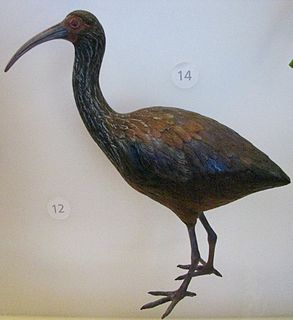 W
WApteribis is an extinct genus of flightless birds in the ibis subfamily that was endemic to the Hawaiian Islands in the Pacific Ocean.
 W
WThe Bishop's ‘ō‘ō or Molokai ‘ō‘ō is a member of the extinct genus of the ‘ō‘ōs (Moho) within the extinct family Mohoidae. It was previously regarded as member of the Australo-Pacific honeyeaters (Meliphagidae). Lionel Walter Rothschild named it after Charles Reed Bishop, the founder of the Bishop Museum.
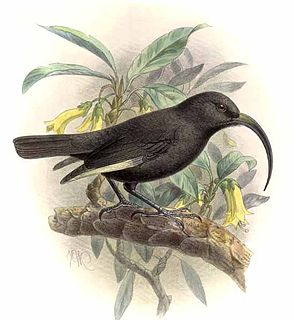 W
WThe black mamo, also known as the hoa, is an extinct species of bird once endemic to the island of Molokai; there is also subfossil evidence of it having lived on Maui.
 W
WChloridops is an extinct genus of Hawaiian honeycreeper in the subfamily Carduelinae of the family Fringillidae.
 W
WCiridops is an extinct genus of Hawaiian honeycreeper species that occurred in prehistoric and historic times on the Hawaiian islands of Hawaii, Molokai, Kauai and Oahu. This genus was created in 1892 by Alfred Newton in an article published by the journal Nature on the basis of the ʻula-ʻai-hawane, which was named Fringilla anna by Sanford B. Dole in 1879.
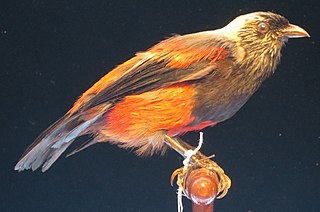 W
WThe ʻula-ʻai-hāwane was a small Hawaiian honeycreeper, now extinct. The term ʻula-ʻai-hāwane is a Hawaiian phrase translating to "red [bird] that eats hāwane". It was only ever reported from the forested mountains of the Kohala, Hilo and Kona districts on the island of Hawaiʻi. Fossil remains reveal that it also existed at one time on other Hawaiian islands. The species is named after Anna Dole, wife of Sanford B. Dole.
 W
WThe great Maui rail or great Maui crake is an extinct bird species from Maui, one of two flightless rails which survived on Maui until people arrived in 150 C.E.
 W
WThe Great Oʻahu crake or Great Oʻahu rail is an extinct bird species that was endemic to the island of Oʻahu in Hawaiʻi. It was one of two flightless rails that had survived on the island until the arrival of people in 200 C.E.
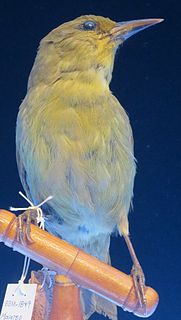 W
WThe greater ʻamakihi was a species of Hawaiian honeycreeper in the subfamily Carduelinae of the family Fringillidae.
 W
WThe greater koa finch was a species of finch in the family Fringillidae. It was found only in the Hawaiian Islands. It has been extinct since the late 19th century.
 W
WThe Hawaiʻi mamo is an extinct species of Hawaiian honeycreeper. It was endemic to Hawaii. It became extinct due to habitat loss, mosquitoes, introduced predators such as mongoose, and over collecting.
 W
WThe Hawaiʻi ʻōʻō is a member of the extinct genus of the ʻōʻōs (Moho) within the extinct family Mohoidae. It was previously regarded as member of the Australo-Pacific honeyeaters (Meliphagidae).
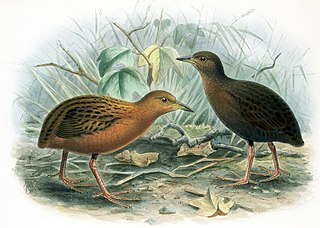 W
WThe Hawaiian rail, Hawaiian spotted rail, or Hawaiian crake is an extinct species of diminutive rail that lived on Big Island of Hawaiʻi.
 W
WThe Oʻahu nukupuʻu was a species of nukupuʻu which was similar to its cousins from the Islands of Kauaʻi and Maui.
 W
WThe lesser ʻakialoa was a species of finch in the family Fringillidae. It was endemic to the island of Hawaii. It became extinct due to habitat loss. It disappeared at around the same time as its Oahu cousin.
 W
WThe high-billed crow or deep-billed crow was a species of large, raven-sized crow that was endemic to the island of Maui in the Hawaiian Islands. It was pushed to extinction due to the arrival of people and pests like rats.
 W
WThe Lānaʻi hookbill is an extinct species of Hawaiian honeycreeper. It was endemic to the island of Lānaʻi in Hawaiʻi, and was last seen in the southwestern part of the island. George C. Munro collected the only known specimen of this species in 1913, which is housed in the Bernice P. Bishop Museum in Honolulu, and saw the species only twice more, once in 1916 and for a final time in 1918. No other sightings have been reported. They inhabited montane dry forests dominated by ʻakoko and ōpuhe. The Lānaʻi hookbill was monotypic within the genus Dysmorodrepanis and had no known subspecies. Its closest relative is believed to be the ʻōʻū, and some early authors suggested that the Lānaʻi hookbill was merely a deformed ʻōʻū. The Lānaʻi hookbill was a plump, medium-sized bird with greenish olive upperparts and pale whitish yellow underparts. It also had a yellow or white superciliary line and a white chin and throat. The wings also had a distinctive and conspicuous white wing patch. The hookbill's distinguishing characteristic was its heavy, parrotlike bill, which had the mandibles hooking sharply towards each other, leaving a gap between them when the beak was closed.
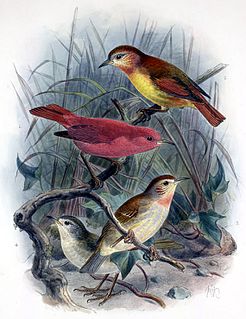 W
WThe kākāwahie or Molokaʻi creeper was a species of Hawaiian honeycreeper. It is extinct, but was found on the Hawaiian island of Molokaʻi in Hawaii.
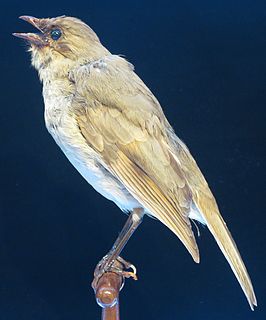 W
WThe kāmaʻo or large Kauaʻi thrush was a small, dark solitaire endemic to Kauaʻi in the Hawaiian Islands.
 W
WThe Kauaʻi ʻōʻō or ʻōʻōʻāʻā was a member of the extinct genus of the ʻōʻōs (Moho) within the extinct family Mohoidae from the islands of Hawai'i. It was previously regarded as member of the Australo-Pacific honeyeaters. This bird was endemic to the island of Kauaʻi. It was common in the subtropical forests of the island until the early twentieth century, when its decline began. Its song was last heard in 1987, and it is now extinct. The causes of its extinction include the introduction of the Polynesian rat, the domestic pig, and mosquitoes, as well as habitat destruction.
 W
WThe kioea was a Hawaiian bird that became extinct around 1859. The kioea was in decline even before the discovery of Hawaiʻi by Europeans. Even native Hawaiians are seemingly unfamiliar with this bird. The feathers of the kioea were not used in Hawaiian featherwork, nor is it mentioned in any chants or legends. Only four specimens exist in museums.
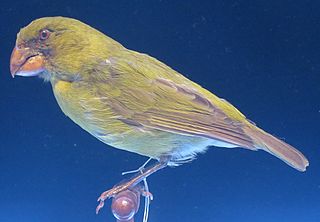 W
WThe Kona grosbeak is an extinct species of Hawaiian honeycreeper. The Kona grosbeak was endemic to naio forests on ʻaʻā lava flows at elevations of 1,400–1,500 metres (4,600–4,900 ft) near the Kona District on the island of Hawaii. The species was already very rare when it was first discovered, being found in only about 10 square kilometres (3.9 sq mi), and was last collected in 1894. Reasons for its extinction are not very well known. The genus is known from fossils from Kauai, Oahu and Maui. It was unknown to the Native Hawaiians, and thus a name for it does not exist in the Hawaiian language.
 W
WThe Lānaʻi ʻalauahio was found on much of the island of Lana'i in the Hawaiian archipelago. It apparently was common until the early 1900s, when there appeared to have been a steep decline in birds on the island. It was similar to the Maui alauahio and this species may have reacted similarly to its existing relative, to which it was considered conspecific. This bird was one of several to vanish from Lana'i, along with others such as the Lanai hookbill.
 W
WThe Laysan honeycreeper or Laysan ʻapapane was an extinct bird species that was endemic to the island of Laysan in the Northwestern Hawaiian Islands.
 W
WThe Laysan millerbird was a subspecies of the millerbird, similar in appearance to the remaining subspecies, the Nihoa millerbird. Its dorsal side was brown, and its belly was grayish. Its name derives from its favorite food, several species of moths of the genus Agrotis commonly referred to as "millers".
 W
WThe Laysan rail or Laysan crake was a flightless bird endemic to the Northwest Hawaiian Island of Laysan. This small island was and still is an important seabird colony, and sustained a number of endemic species, including the rail. It became extinct due to habitat loss by domestic rabbits, and ultimately World War II.
 W
WThe lesser koa finch is an extinct species of Hawaiian honeycreeper.
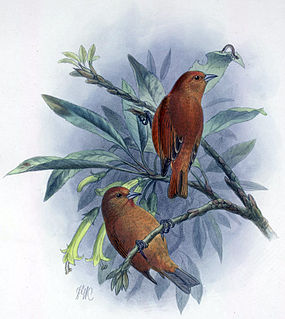 W
WThe Oʻahu ʻakepa is an extinct species of ʻakepa that was endemic to the island of Oahu. It was commonly sighted throughout the 19th century. This brick red Hawaiian honeycreeper was found in the mountain peaks in densely forested areas. The females were mostly gray with a tinge of green. The birds had a slight crossbill just like the other Loxops species. It used its crossbill to open up buds in search for nectar and insects for it to eat. Its most common haunts were the ʻōhiʻa and koa forests that were filled with the many flowers and insects that this species liked to eat. The Oʻahu ʻakepa is one of three different species of ʻakepa that were spread by possible weather and migration. The movement of the species stopped causing the species to break into four branches. The first branch was the Hawaiian ʻakepa, a scarlet- red bird that lives only on the Big Island and may be the ancestor of the genus Loxops. Next is the Maui ʻakepa, which was found as fossils on all the islands of Maui Nui, but was historically seen on Maui. It is a grayish-orange bird that was the first of the ʻakepa species to disappear. Then came the Oʻahu ʻakepa, which is a brick red color and was seen till around the 1900s when it became extinct. The last branch was the ‘akeke‘e, a green bird that is only found on the island of Kauai.
 W
WMamo or woowoo is a common name for two species of extinct birds. Together with the extant ʻIʻiwi they make up the genus Drepanis. These nectarivorous finches were endemic to Hawaii but are now extinct.
 W
WThe Maui ʻakepa is a species of ʻakepa native to Maui in the Hawaiian Islands, and which was common throughout the island. Introduced mosquitoes and other animals to Maui contributed to the declining population, and the bird is considered critically endangered by the IUCN Red List of Threatened Species. The last reported sighting of this bird was in 1988, and it is possibly extinct.
 W
WThe Maui nukupuʻu is a species of nukupu‘u Hawaiian honeycreeper that is endemic to the island of Maui in the Hawaiian Islands. The small, five-inch-long bird lives only in eastern Maui, where it is dependent on high-elevation mesic and wet forests of ʻōhiʻa lehua and koa. These two species of trees attract insects, causing the Maui nukupuʻu to have a higher chance of finding a meal near these trees.
 W
WThe moa-nalo are a group of extinct aberrant, goose-like ducks that lived on the larger Hawaiian Islands, except Hawaiʻi itself, in the Pacific. They were the major herbivores on most of these islands until they became extinct after human settlement.
 W
WThe Maui Nui large-billed moa-nalo, also known as the Maui Nui moa-nalo, is one of two species of moa-nalo in the genus Thambetochen. Moa-nalo are a group of extinct, flightless, large goose-like ducks, which evolved in the Hawaiian Islands of the North Pacific Ocean.
 W
WThe Oʻahu moa-nalo is one of two species of moa-nalo in the genus Thambetochen. Moa-nalo are a group of extinct, flightless, large goose-like ducks, which evolved in the Hawaiian Islands of the North Pacific Ocean.
 W
WThe small-billed moa-nalo, also known as the stumbling moa-nalo, is a species of moa-nalo, one of a group of extinct, flightless, large goose-like ducks, which evolved in the Hawaiian Islands of the North Pacific Ocean. It was described in 1991 from subfossil material collected in September 1982 by Storrs Olson, Helen James and others, from the Auwahi Cave on the southern slopes of Haleakalā, on the island of Maui.
 W
WThe turtle-jawed moa-nalo, also formerly referred to as the large Kauai goose, is a species of moa-nalo, one of a group of extinct, flightless, large goose-like ducks, which evolved in the Hawaiian Islands of the North Pacific Ocean. It was described in 1991 from subfossil material collected in 1976 by Storrs Olson from the calcareous Makawehi dunes on the south-eastern coast of the island of Kauai. Its remains have also been found at the nearby Makauwahi Cave site.
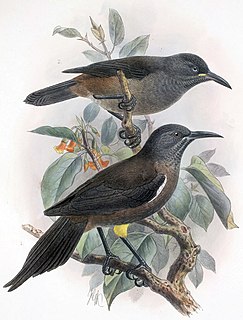 W
WMoho is a genus of extinct birds in the Hawaiian bird family, Mohoidae, that were endemic to the Hawaiian Islands. Members of the genus are known as ʻōʻō in the Hawaiian language. Their plumage was generally striking glossy black; some species had yellowish axillary tufts and other black outer feathers. Most of these species became extinct by habitat loss and by extensive hunting because their plumage was used for the creation of precious ʻaʻahu aliʻi (robes) and ʻahu ʻula (capes) for aliʻi. The Kauaʻi ʻōʻō was the last species of this genus to become extinct, probably a victim of avian malaria.
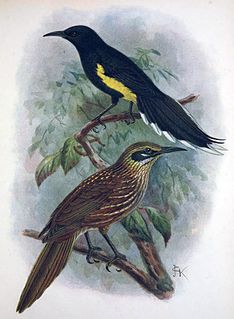 W
WMohoidae is a family of Hawaiian species of recently extinct, nectarivorous songbirds in the genera Moho (ʻōʻō) and Chaetoptila (kioea). These now extinct birds form their own family, representing the only complete extinction of an entire avian family in modern times, when the disputed family Turnagridae is regarded as invalid.
 W
WThe nukupuʻu is a group of critically endangered species of Hawaiian honeycreeper in the family Fringillidae. There are no recent confirmed records for any of the species and they may be extinct or functionally extinct. Habitat was dense mesic and wet forest of ʻōhiʻa lehua and koa at altitudes of 3,300–6,600 feet (1,000–2,000 m).
 W
WThe Oʻahu ʻakepa is an extinct species of ʻakepa that was endemic to the island of Oahu. It was commonly sighted throughout the 19th century. This brick red Hawaiian honeycreeper was found in the mountain peaks in densely forested areas. The females were mostly gray with a tinge of green. The birds had a slight crossbill just like the other Loxops species. It used its crossbill to open up buds in search for nectar and insects for it to eat. Its most common haunts were the ʻōhiʻa and koa forests that were filled with the many flowers and insects that this species liked to eat. The Oʻahu ʻakepa is one of three different species of ʻakepa that were spread by possible weather and migration. The movement of the species stopped causing the species to break into four branches. The first branch was the Hawaiian ʻakepa, a scarlet- red bird that lives only on the Big Island and may be the ancestor of the genus Loxops. Next is the Maui ʻakepa, which was found as fossils on all the islands of Maui Nui, but was historically seen on Maui. It is a grayish-orange bird that was the first of the ʻakepa species to disappear. Then came the Oʻahu ʻakepa, which is a brick red color and was seen till around the 1900s when it became extinct. The last branch was the ‘akeke‘e, a green bird that is only found on the island of Kauai.
 W
WThe Oʻahu nukupuʻu was a species of nukupuʻu which was similar to its cousins from the Islands of Kauaʻi and Maui.
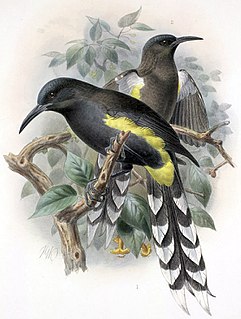 W
WThe O‘ahu ‘ō‘ō is a member of the extinct genus of the ‘ō‘ōs (Moho) within the extinct family Mohoidae. It was previously regarded as member of the Australo-Pacific honeyeaters (Meliphagidae).
 W
WThe Kona grosbeak is an extinct species of Hawaiian honeycreeper. The Kona grosbeak was endemic to naio forests on ʻaʻā lava flows at elevations of 1,400–1,500 metres (4,600–4,900 ft) near the Kona District on the island of Hawaii. The species was already very rare when it was first discovered, being found in only about 10 square kilometres (3.9 sq mi), and was last collected in 1894. Reasons for its extinction are not very well known. The genus is known from fossils from Kauai, Oahu and Maui. It was unknown to the Native Hawaiians, and thus a name for it does not exist in the Hawaiian language.
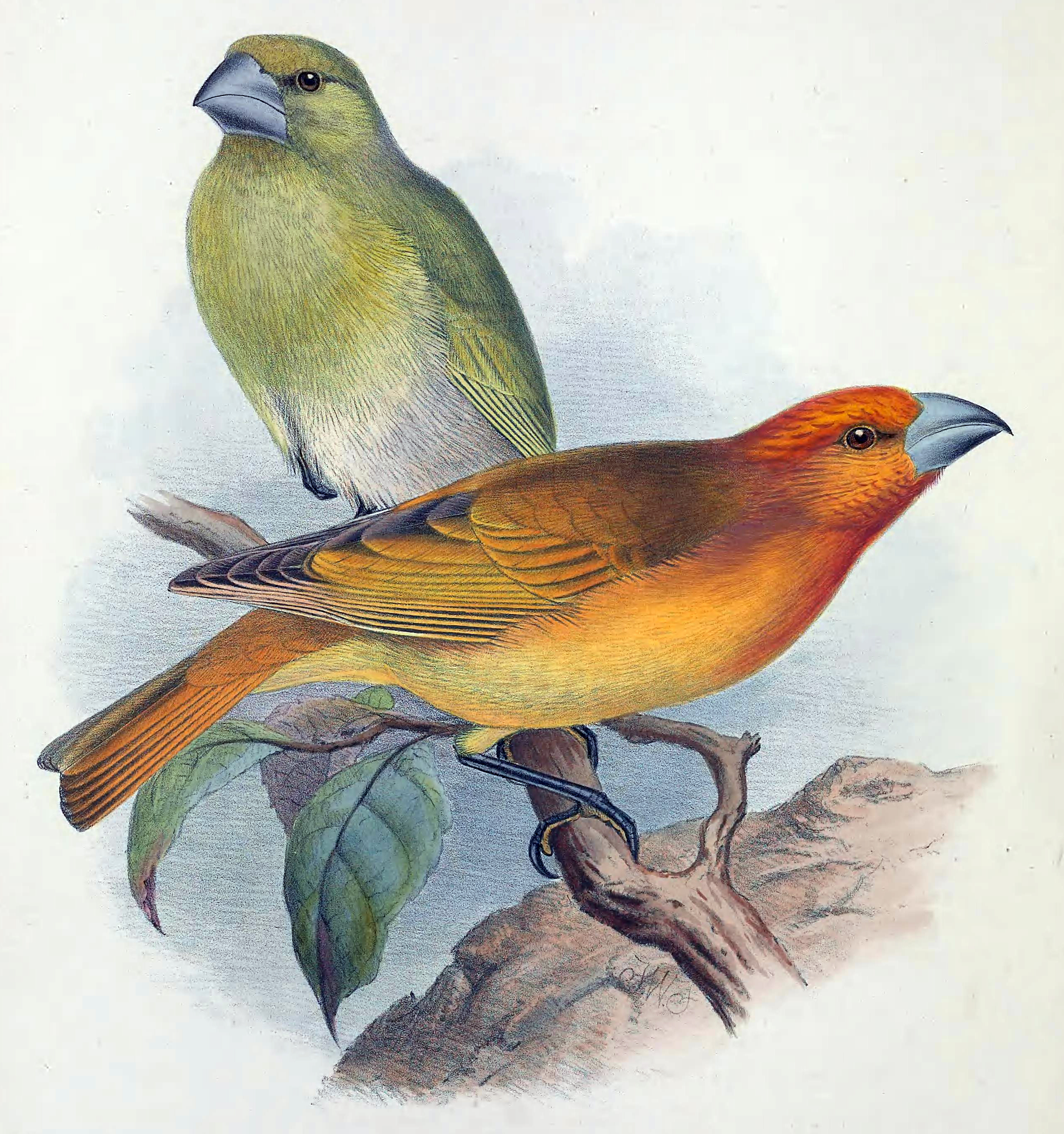 W
WRhodacanthis is an extinct genus of Hawaiian honeycreeper. All four species were endemic to the Hawaiian Islands. Members of this genus were granivores, with bills adapted to the seeds and pods of legumes. The two species that became extinct in the 1890s, R. flaviceps and R. palmeri, inhabited upper elevation mesic forests dominated by koa (Acacia koa) on the island of Hawaiʻi. Both were large birds; R. flaviceps measured 19 cm (7.5 in), while R. palmeri was 23 cm (9.1 in) in length. The combination of a giant bill with brightly colored plumage gave the males a very striking appearance. Koa seeds were the preferred food for the two species, but caterpillars were taken if necessary. The two prehistoric species, R. forfex and R. litotes, were denizens of more lowland tropical dry forests and shrublands on Kauaʻi, Maui, and Oʻahu. It is speculated that koaiʻa was an important food source for both species, as their range did not overlap with that of koa. Kanaloa pods and ʻaʻaliʻi berries were probably also eaten in addition to the occasional caterpillar.
 W
WThambetochen is an extinct genus of moa-nalo duck. It contains two species, the Maui Nui moa-nalo and the smaller O'ahu moa-nalo.
 W
WThe ʻula-ʻai-hāwane was a small Hawaiian honeycreeper, now extinct. The term ʻula-ʻai-hāwane is a Hawaiian phrase translating to "red [bird] that eats hāwane". It was only ever reported from the forested mountains of the Kohala, Hilo and Kona districts on the island of Hawaiʻi. Fossil remains reveal that it also existed at one time on other Hawaiian islands. The species is named after Anna Dole, wife of Sanford B. Dole.
 W
WThe greater ʻamakihi was a species of Hawaiian honeycreeper in the subfamily Carduelinae of the family Fringillidae.